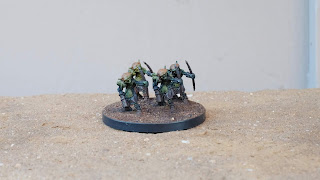 |
| Goblins |
This is a terrible way to begin painting. The prospect of completing such a task is totally overwhelming, and the new painter usually ends up with a pretty shit looking army, because they suck. Couple this with with professionally painted box art, and the new painter's morale is completely devastated, and they move on to less demanding hobbies/games.
 |
| More Goblins |
Highly motivated individuals try to lean speed painting techniques, and buy more gear (air brushes, big brushes, watch hours of videos, etc), and then grind it out. The result isn't as fast or as good as a good as a good speed paint, and the results are usually still shit, because they suck at painting (everyone sucks when they start).
 |
| Even more Goblins |
By only painting for fun and learning on single miniatures, the painter acquires critical skills, which, as it turn out, makes them better able to cope when confronted by daunting tasks.
 |
| Mehr noch mehr Kobolde |
Recently I decided to give speed painting a go, (for some D&D figures). While I've painted squads and teams in the past, I've always approached them with a "time doesn't matter" approach, which means that they take months for me to complete. This time I painted everything in about 4 sessions over 2 weeks.
 |
| More F#$%ing Goblins |
Speed painting actually requires a decent set of skills to pull off well. Interestingly, it might actually help the more advanced painter, as it teaches where corners can be cut, and it reinforces good basics. Essentially, working at speed painting will probably not help a beginner become better at anything, but it might help an intermediate painter get better at everything!
 |
| Uninspired Archers (I was fed up) |
Key things to keep in mind:
- Get everything ready before you start, paint selection, primed figures, water snacks, etc.
- You can't see crap at 3 feet, so blending is for fools, stick to layering (wet palette).
- Contrast is everything, start from a black base coat and leave lots showing, these are your shadows.
- Keep the color palette small, a primary for most (black, white, color, highlight 1, highlight 2?), and brown and black for almost everything else. (KISS, keep it simple stupid).
- Dry-brush and over-brush are acceptable techniques (KISS).
- Work from the inside out so know where you can be sloppy and what's going to get painted over layer.
- Heavy washes (contrast, KISS).
- Spend time on the face (highlight, contrast)
- Spend time on heroes, and bosses (highlight additional details).
- Paint similar figures in batch mode, all skin, then all armor, then all wood leather, etc. (wet palette, reduced palette).
- Practice using a timer, 10-15 min/figure.
 |
| Goblin Warriors |
 |
| Goblin Champions (I actually like the three left most) |
The more figures you have the more the eye wanders and the less time it spends dissecting each figure, this is what saves you. Individually none of these are winners, but when 30+ Goblins storm your players...
 |
| Goblin Horde |
 |
| Better Run! The Goblins are coming. |
As always, I'm not an expert, just some clown on the internet, take it or leave it.
Good luck,
and remember DMGWLFP.
HMP
No comments:
Post a Comment